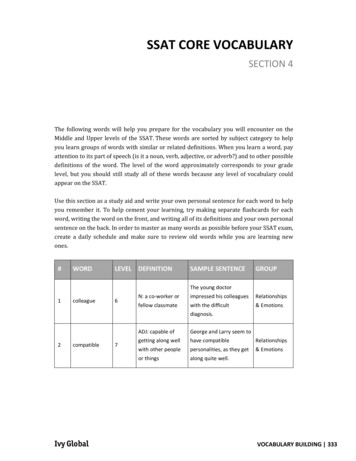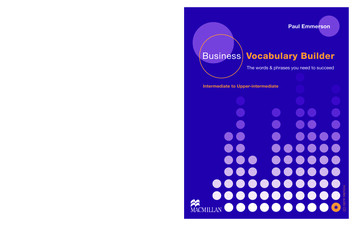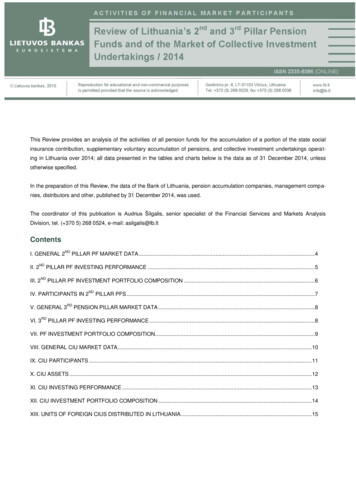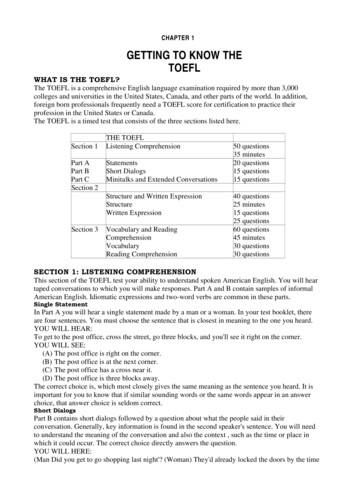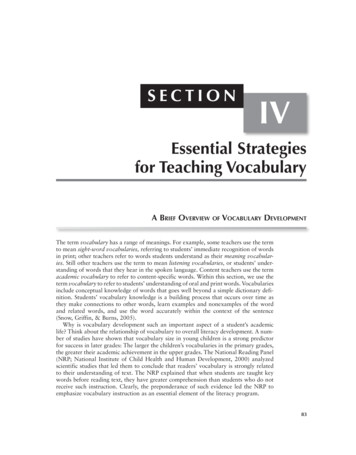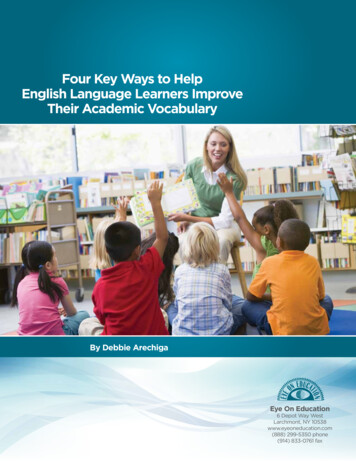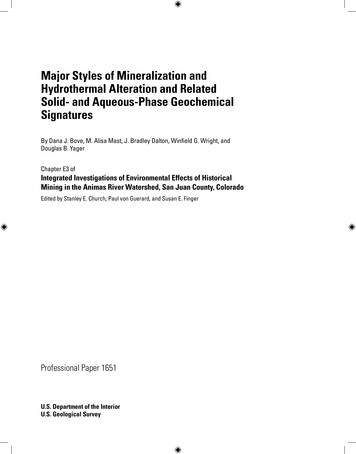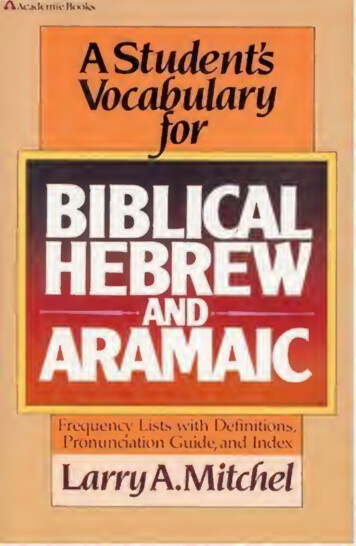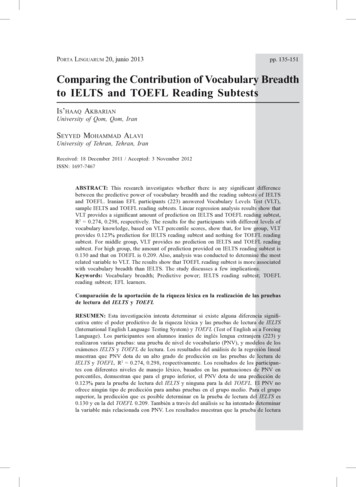
Transcription
Porta Linguarum 20, junio 2013pp. 135-151Comparing the Contribution of Vocabulary Breadthto IELTS and TOEFL Reading SubtestsIs’haaq AkbarianUniversity of Qom, Qom, IranSeyyed Mohammad AlaviUniversity of Tehran, Tehran, IranReceived: 18 December 2011 / Accepted: 3 November 2012ISSN: 1697-7467Abstract: This research investigates whether there is any significant differencebetween the predictive power of vocabulary breadth and the reading subtests of IELTSand TOEFL. Iranian EFL participants (223) answered Vocabulary Levels Test (VLT),sample IELTS and TOEFL reading subtests. Linear regression analysis results show thatVLT provides a significant amount of prediction on IELTS and TOEFL reading subtest,R2 0.274, 0.298, respectively. The results for the participants with different levels ofvocabulary knowledge, based on VLT percentile scores, show that, for low group, VLTprovides 0.123% prediction for IELTS reading subtest and nothing for TOEFL readingsubtest. For middle group, VLT provides no prediction on IELTS and TOEFL readingsubtest. For high group, the amount of prediction provided on IELTS reading subtest is0.130 and that on TOEFL is 0.209. Also, analysis was conducted to determine the mostrelated variable to VLT. The results show that TOEFL reading subtest is more associatedwith vocabulary breadth than IELTS. The study discusses a few implications.Keywords: Vocabulary breadth; Predictive power; IELTS reading subtest; TOEFLreading subtest; EFL learners.Comparación de la aportación de la riqueza léxica en la realización de las pruebasde lectura del IELTS y TOEFLRESUMEN: Esta investigación intenta determinar si existe alguna diferencia significativa entre el poder predictivo de la riqueza léxica y las pruebas de lectura de IELTS(International English Language Testing System) y TOEFL (Test of English as a ForeingLanguage). Los participantes son alumnos iraníes de inglés lengua extranjera (223) yrealizaron varias pruebas: una prueba de nivel de vocabulario (PNV), y modelos de losexámenes IELTS y TOEFL de lectura. Los resultados del análisis de la regresión linealmuestran que PNV dota de un alto grado de predicción en las pruebas de lectura deIELTS y TOEFL, R2 0.274, 0.298, respectivamente. Los resultados de los participantes con diferentes niveles de manejo léxico, basados en las puntuaciones de PNV enpercentiles, demuestran que para el grupo inferior, el PNV dota de una predicción de0.123% para la prueba de lectura del IELTS y ninguna para la del TOEFL. El PNV noofrece ningún tipo de predicción para ambas pruebas en el grupo medio. Para el gruposuperior, la predicción que es posible determinar en la prueba de lectura del IELTS es0.130 y en la del TOEFL 0.209. También a través del análisis se ha intentado determinarla variable más relacionada con PNV. Los resultados muestran que la prueba de lectura
Porta LinguarumNº 20, junio 2013del TOEFL está más asociada a la riqueza léxica que la prueba del IELTS. Además seha reflexionado sobre las consecuencias de los datos obtenidos.Palabras clave: riqueza léxica; poder predictivo; prueba de lectura IELTS; prueba delectura TOEFL; estudiantes de inglés lengua extranjera.1. IntroductionVocabulary knowledge is no longer regarded as the Cinderella of language learning andteaching. Yet, Milton et al. (2008) indicate that fresh vocabulary research can still providesome contributions to the practice of language pedagogy. These researchers talk about severaldirect ways in which vocabulary research can contribute to the task of teaching and learninglanguages. Vocabulary research, according to Milton et al. (2008: 123–137), can help us (a)understand “how language is constructed, how it is learned, and how it is used in communication”, (b) “establish norms of progress and even standards of knowledge and performance”,(c) “understand and control language input”, and (d) select “appropriate methodologies andtechniques to enhance progress and performance” of language learners. These potential rolesof vocabulary research, as Akbarian (2010) suggests, might be the reason why researchersare motivated to investigate vocabulary from different novel perspectives.Though there are many studies conducted on the relation hip between vocabularyknowledge and different aspects of language proficiency, there is still an absence of studiesexploring the extent to which vocabulary size contributes to the different language skills.(Stæhr, 2008: 139) and sub-skills (Alavi & Akbarian, 2012). More particularly, few studiestry to link vocabulary breadth to high-stakes examinations, such as IELTS (Milton, 2009). Asa matter of fact, Milton’s (2009) volume which is an update on issues in assessing vocabulary does not report any investigation exploring the comparative contribution of vocabularybreadth to the reading section of IELTS and TOEFL in foreign language situations. Giventhat, the current research reports the results of an empirical study, addressing the extent towhich the size or breadth of vocabulary knowledge is associated with the reading subtestsof these two widely used proficiency tests.2. Reviewof theLiteratureApparently, the association between vocabulary breadth and reading comprehension hasbeen explored from two perspectives in the literature: Firstly, this issue is linked with thequestion of how many words in a text a language learner needs to know so as to comprehendthat text adequately (Stæhr, 2008). Secondly, more empirical investigations have been reportedon finding the mere relationship between vocabulary breadth and reading comprehension orskill. In essence, the studies on vocabulary breadth and reading skill exceed those relatedto the other skills.In accordance with the first line of research, Hu and Nation (2000) examined the relationship between text coverage, i.e. the percentage of running known words in the text, andreading comprehension for non-native speakers of English. The researchers showed that 98%text coverage (1 unknown word in 50) would be needed for most learners to comprehenda fiction text adequately.136
Is haaq Akbarian and Seyyed Mohammad AlaviComparing the Contribution of Vocabulary.Also, on the basis of the British National Corpus, Nation (2006) conducted a trialling of 14most frequent 1,000 word-family lists and used them to detect what vocabulary breadth wouldbe needed for unassisted comprehension of written and spoken English. Taking a lexical coverage of 98% of any text as the ideal coverage for unassisted comprehension, Nation states thata 8,000 to 9,000 word-family vocabulary is needed for comprehension of written text anda vocabulary of 6,000 to 7,000 for spoken text(p. 59).In line with the second perspective, more researches have been reported. For instance,Qian (1999) carried out an investigation on the relationship between vocabulary breadth,vocabulary depth, and reading comprehension of Chinese and Korean English learners.His results displayed high inter-correlations between these variables, ranging from 0.78 to0.82. As a follow-up to this study, Qian (2002) conducted another study to conceptuallyvalidate the roles of breadth and depth of vocabulary knowledge in reading comprehensionin academic settings using a heterogeneous sample of mixed first language backgrounds. Heused a refined version of the depth-of-vocabulary-knowledge (DVK) test of Read (1995),reading for basic comprehension measure (TOEFL-RBC), a vocabulary size (VS) measuredeveloped by Nation (1983), and a TOEFL vocabulary measure (VM). Qian showed thatthere were high inter-correlations between the scores on the DVK, VS, TOEFL VM, andTOEFL-RBC. A strong significant correlation was displayed between VS test and TOEFLRBC (r 0.74, p 0.01).Administering Vocabulary Levels Test (VLT), the Productive Version of the VLT, anda TOEFL test to 76 Iranian undergraduate students, Golkar and Yamini (2007) examined therelationship between active and passive vocabulary knowledge, and the learners’ proficiencylevel and reading comprehension ability. What is significant to our interest is that vocabulary size turned out to have a high and significant correlation with both proficiency levelsand the reading comprehension ability. The correlation between their passive and activevocabularies and reading comprehension ability produced a coefficient of 0.75 and 0.80,respectively, with active vocabulary showing a higher index. The researchers attribute it tothe fact that “passive knowledge takes much practice and experience in language to turninto active”, and conclude that language learners “with a higher active vocabulary have hada higher amount of practice in reading texts, too; hence their better reading comprehensionability” (p. 101).In a recent study, Zhang and Anual (2008) explored the role of vocabulary knowledgein reading comprehension with 37 year-4 secondary students in Singapore. They used VLTto measure students’ vocabulary knowledge in relation to the different measures, i.e. shortanswer questions and summary task, intended to test their reading comprehension. Vocabularyknowledge at the 2,000-word level and reading comprehension significantly (r 0.423, p 0.01) correlated together, while at the 3,000-word level, a strong significant correlationwas produced for the short-answer questions (r 0.848, p 0.01). At the 5,000-word level,the correlation was not significant for the short-answer questions. However, no significantcorrelation was displayed for the summary task at any level. For this, the researchers suspectthat different task formats might have affected comprehension performance.Stæhr (2008) investigated the relationship between vocabulary breadth and the readingskill, in addition to writing and listening of Danish learners of English from lower secondary education whose language skills were assessed as part of the national school leavingexamination. Vocabulary size displayed a high correlation of 0.83 (p .01) with readingcomprehension, thus indicating the reading skill to be the most dependent on vocabulary sizein that study. The researcher further found that the participants, knowing the most frequent137
Porta LinguarumNº 20, junio 20132,000 word families, obtained a score above average on reading and the other two skills,while for those not mastering the most frequent 2,000 word families, “the picture was lessclear” (Stæhr, 2008: 149).Whereas there are several investigations using the reading section of TOEFL, researchershave not conducted any studies, other than Milton, Wade, and Hopkins (2010), to correlatevocabulary breadth with the reading section of IELTS or to compare the importance ofvocabulary breadth in these two widely used tests.Using 30 EFL learners as participants, Milton, et al. (2010) correlated two receptivevocabulary size measures, the X Lex (Meara & Milton, 2003) and the A Lex (Milton &Hopkins, 2005), with the IELTS test. They used Spearman correlations, producing a signicorrelate vocabularywith the readingsectionof IELTSto comparethe theficanttocoefficientof .699 forbreadththe relationshipbetweenvocabularysizeor(theX Lex) andimportance of vocabulary breadth in these two widely used tests.reading component of IELTS. Actually, vocabulary size explains nearly 50 per cent of theUsing 30 EFL learners as participants, Milton, Wade, and Hopkins (2010) correlatedvariancein the readingscoresIELTS. the X Lex (Meara & Milton, 2003) and the A Lextwo onofthestudies,in whichrole usedof vocabularyreading com(Milton & Hopkins, 2005), withthe IELTStest.theTheySpearman incorrelations,prehensionwasa investigated,shows thattherepaucity betweenof researchin the sizefield.(theSince,producingsignificant coefficientof .699for isthestillrelationshipvocabularyan understandingof readingthis relationshipessentialto vocabularythe field andlanguageeducation,X Lex) and nearly50per centvariancethethisreadingscores ofIELTS.this studyis ofantheattempttoinfillparticulargap.The above-cited studies, showing paucity of research in the area, merit anotherinvestigationinto the role of vocabulary breadth for reading comprehension in two widely2.1. Researchquestionused tests, i.e. TOEFL and IELTS reading subtests. The following question, therefore,guides our investigation:The present study aimed to investigate the role of vocabulary breadth for reading comprehension in two widely-used proficiency tests, i.e. TOEFL and IELTS reading subtests. To2.1. Research questionthis end, the following research question guided this investigation:Is ybreadthIs thereanysignificantsignificantdifferencedifference betweenbetween theof ofvocabularybreadthand thereadingsubtestsofIELTSandTOEFL?and the reading subtests of IELTS and TOEFL?3. METHODParticipants3. M3.1.ethodThere were 202 participating EFL students on IELTS and 223 on TOEFL from different3.1. ParticipantsIranian universities. They ranged from BA sophomores studying English literature to MAstudents studying TEFL (Table 1). VLT was used to classify the participants into threeThere were202 participatingstudentslevels.on IELTSand 223TOEFL fromdifferentgroupswith articipantsinto threeIranianuniversities.Theyfrom BAranksophomoresstudyingEnglishliteratureto MAgroupswas basedon rangedtheir percentilein the scoreson ot TEFLthat(Table1). VLT wasusedto classifythe EFLparticipantsthree groupslevel.with knowledgedifferent vocabularyproficiency levels. Classifying the participants into three groupswas based on their percentile rank in the scores on VLT (discussed later). Experience showsthat sometimes degree does not show EFL learners’ vocabulary knowledge level.Table 1Profile of the ParticipantsTestTable 1. Profile of the 2233.2. Materials138To conduct this research, three tests were administered: Vocabulary Levels Test, thereading section of IELTS (40 items), and the reading section of TOEFL (50 items):3.2.1. Vocabulary Levels Test (VLT)Version 2 of VLT, revised and validated by Schmitt, Schmitt, and Clapham (2001), wasused in this study. According to Nation (1990), the vocabulary of English (and indeed any
Is haaq Akbarian and Seyyed Mohammad AlaviComparing the Contribution of Vocabulary.3.2. MaterialsTo conduct this research, three tests were employed. They are Vocabulary Levels Test(VLT), the reading section of IELTS containing 40 items, and the reading section of TOEFLconsisting of 50 items.3.2.1. Vocabulary Levels Test (VLT)Version 2 of VLT, revised and validated by Schmitt, Schmitt, and Clapham (2001), wasused in this study. According to Nation (1990), the vocabulary of English (and indeed anylanguage) can be viewed as consisting of a series of levels based on frequency of occurrence.The levels contain groups of 1,000 words. So VLT measures knowledge of words at fivelevels: 2,000, 3,000, 5,000, 10,000, and Academic Vocabulary section that is not used sinceit is different in kind from the other levels and should not be included in the profile comparison (Schmitt et al., 2001). At each level, there are 10 three-item clusters (i.e., 30 items).Twenty four correct answers at a level is the criterion for its mastery (N. Schmitt, personalcommunication, May 9, 2008). With 88 participants, Stæhr (2008) calculated the Cronbach’salpha of this version of VLT at 0.96. Interestingly enough, in the current study, Cronbach’salpha on VLT at the four 1,000-, 3,000-, 5,000-, and 10,000-word frequency levels was alsocalculated at 0.963. The following is an �� part of a house—— animal with four legs—— something used for writing3.2.2. IELTS Reading SubtestLynda Taylor, an authority in the field, recommended the use of published practicematerials (L. Taylor, personal communication, November 6, 2006) since live versions ofIELTS reading are not released for research purposes. Given that, past exam papers fromthe reading section of Test 1, Cambridge IELTS 5 (2006: 16 28), were used.In this study, Academic Reading module was used. This module consists of three sectionscontaining passages (with a total of 2,000 to 2,750 words), taken from magazines, journals,books, and newspapers. At least one passage contains detailed logical argument.3.2.3. TOEFL Reading SubtestGenuine running TOEFL is not released either. Official practice tests and TOEFL actualtests (administered in the past by ETS) have been published. Therefore, the (pBT) readingsection of January 2004 version (TOEFL ACTUAL TESTS, 2005: 25 35) was used for thesake of reliability and the lack of technological facilities in our context for iBT versions.139
Porta LinguarumNº 20, junio 2013TOEFL reading subtest includes several passages (here five) with multiple-choicequestions, between 250 and 350 words long, taken from college-level textbooks used inintroductions to a discipline or topic.It is worth noting here that the reference to IELTS and TOEFL reading subtests throughout the current study is to a sample of IELTS and TOEFL tests used in Iran, not the realIELTS and TOEFL test.3.3. Procedures and data analysesWilling and generous to respond, and informed of the purpose of the tests for researchpurposes, the participants answered the tests in separate sessions in the following order: VLT(30 min), TOEFL reading subtest (55 min), and IELTS reading subtest (60 min).The tests were administered in non-class periods. As a result, out of the original poolof 296 participants answering VLT, not all of them were able to respond to all the aboveinstruments; some did not turn up in the session on TOEFL or IELTS for personal problemswhile some were unwilling to continue after answering VLT. Still, some others were unableto answer all the items on TOEFL and IELTS in due time. Therefore, they were excludedfrom the analysis, too.VLT was regarded as the independent variable and IELTS and TOEFL were taken asthe dependent variables in their respective analyses. Linear regression analysis was performed to investigate the predictive power of vocabulary knowledge on the reading subtest ofIELTS and TOEFL. To delve into the issue further, a series of linear regression analyseswere conducted on the data to report the predictive values of vocabulary knowledge in IELTSand TOEFL reading subtests with regard to the overall performance of the participants onVLT and their performance on the four levels of word frequency bands (i.e., across levels).At this stage, the grouping into vocabulary proficiency levels was done based on the participants’ percentile rank for the scores they obtained on VLT. The overall alpha significancelevel was preset at p .05 for all the analyses.4. ResultsThe research question aims to answer whether there is any significant difference between the predictive power of vocabulary breadth and the reading subtest of IELTS andTOEFL, in answer to which the participants are first considered as one group, irrespectiveof the difference in their level among them, and then divided into three groups. Moreover,since there is difference in the number of the participants on IELTS and TOEFL, the studyseparately presents the results in the order of IELTS, TOEFL, and the comparison betweenthese two tests.With respect to the overall performance of the participants on VLT as one compositevariable, the descriptive statistics in Table 2 and 3 provide a general profile of the participants’ performance.140
between the predictive power of vocabulary breadth and the reading subtest of IELTS andbetweenpredictivepowertheof participantsvocabulary breadththe readingsubtestof irrespectiveIELTS andTOEFL, thein answerto whichare first andconsideredas onegroup,TOEFL,in answerwhichparticipantsare firstone group,ofthe differencein totheirleveltheamongthem, andthen considereddivided ifferencein theirinlevelthen dividedinto threesinceis differencethe amongnumberthem,of theandparticipantson IELTSand groups.TOEFL,Moreover,the studysince therepresentsis differencein the innumberof theparticipantson IELTSTOEFL, thestudyseparatelythe resultsthe orderof IELTS,TOEFL,and theandcomparisonbetweenseparatelypresents the results in the order of IELTS, TOEFL, and the comparison betweenthese two tests.thesetworespecttests. to the overall performance of the participants on VLT as one compositeWithWith respectto the overallperformanceas onecompositevariable,the descriptivestatisticsin Tableof2 theandparticipants3 provide ona VLTgeneralprofileof ovideageneralprofileof theparticipants’ performance.participants’performance.Is haaqAkbarianand Seyyed Mohammad Alavi Comparing the Contribution of Vocabulary.Table 2Table 2DescriptiveStatistics for the Reading Subtest of IELTS and VLTTable Statistics2. DescriptiveStatisticsforof theReadingDescriptivefor the ReadingSubtestIELTSand VLT Subtest of IELTS and VLT.MPSMPS4040120120IELTS reading subtestIELTS reading subtestVLTVLTMeanMean22.6322.6376.7976.79Std. DeviationStd. Deviation6.196.1916.5416.54NN202202202202Note: MPS Maximum Possible ScoreNote: MPS Maximum Possible ScoreTable 33. DescriptiveStatisticsforoftheReadingSubtest of TOEFL and VLT.TableTable3DescriptiveStatisticsfor the ReadingSubtestTOEFLand VLTDescriptive Statistics for the Reading Subtest of TOEFL and VLTMPSMPS5050120120TOEFL reading subtestTOEFL reading subtestVLTVLTMeanMean30.5830.5876.6876.68Std. DeviationStd. Deviation8.938.9316.4216.42NN223223223223Note: MPS Maximum Possible ScoreNote: MPS Maximum Possible ScoreSimpleanalysiswaswasconductedto determinethe predictivepower ofSimple tedto determinethe predictivepowervocabularyknowledge,knowledge, asas capturedcaptured inin t.TheTheresultsresultsillusof vocabularya iables, VLTtratedillustratedin betweenthethetwoVLT mmaryforVLTand IELTSthe reading subtest of IELTS. In2 the table of model summary for VLT and IELTS readingreading subtest, R 0.524, R 0.271. This suggests that VLT and the reading subtest ofsubtest R 0.524, R2 0.271. This suggests that VLT and the reading subtest of IELTSIELTS actually overlap one another to some extent: VLT has 27% explained variance in theactuallyoverlapone anotherto some extent: VLT has 27% explained variance in the readingreadingsubsectionof IELTS.subsection of IELTS.Table 4Model Summaryand IELTSReadingforSubtestTablefor4.VLTModelSummaryVLT and IELTS Reading Subtest.Model1R0.524aRSquareAdjustedR SquareStd. Errorof theEstimate0 .2740 .2715.28243Change StatisticsRSquareChangeFChangeDf1df2Sig. FChange0 .27475.61912000.000a. Predictors: (Constant), VLTb. Dependent Variable: IELTS reading subtestTopercentageof increasein the inindependentvariable andthe resultantchangeTo illustrateillustratethethepercentageof increasethe independentvariableand theresultantin the dependent variable, Table 5 shows that we obtained a 7.591 for the intercept and bchange in the dependent variable, Table 5 shows that we obtained a 7.591 for the intercept .196 for the slope. So, given the data, for each percentage of increase in VLT scores, theand b 0.196 for the slope. So, given the data, for each percentage of increase in VLTscores on the reading subsection of IELTS change b (.196) units.scores, the scores on the reading subsection of IELTS change b (0.196) units.Table 5CoefficientsModel1UnstandardizedCoefficientsBStd. efficientstSig.4.290.0008.696.000Beta.524141a. Predictors: (Constant), VLTb. Dependent Variable: IELTS reading subtestSimilarly, linear regression analysis was used to analyze the data collected on TOEFL
1.524.274.2715.28243.27475.6191200.000a. Predictors: (Constant), VLTb. Dependent Variable: IELTS reading subtestTo illustrate the percentage of increase in the independent variable and the resultant changein the dependent variable, Table 5 shows that we obtained a 7.591 for the intercept and b .196 for the slope. So, given the data, for each percentage of increase in VLT scores, thescores on the reading subsection of IELTS change b (.196) units.Porta LinguarumNº 20, junio 2013Table 5CoefficientsTable 5. ficientsBStd. Error7.5911.7690 .1960 .023StandardizedCoefficientstSig.4.2900.0008.6960 .000Beta0 .524a. Predictors: (Constant), VLTb. Dependent Variable: IELTS reading subtestSimilarly, susedanalyzecollectedon TOEFLSimilarly,wasusedto toanalyzethe thedatadatacollectedon TOEFLreadingsubtest.Table6 shows,a amoderatemoderate positivebetweenthe tworeadingsubtest.As AsTable6 tweenthe twovariablesof VLTreadingsubtestsubtest ofis, is,R R0.546.The indexseems tovariablesof VLTandandthethereadingofTOEFL.TOEFL.ThatThat 0.546.The indexseemsslightly higherhigher thanthatof ofIELTSabove.The correspondingcoefficientof determinationto fficientofdetermi(adjustedR2),Rresultingfrom fromPearsoncorrelationcoefficient,is considerable:R2 0.295.R 2 2), resultingPearsoncorrelationcoefficient,is considerable:nation(adjustedLikewise, it suggests that VLT and the reading subtest of TOEFL actually overlap one0.295. Likewise, it suggests that VLT and the reading subtest of TOEFL actually overlapanother to some extent: VLT can explain approximately 30% of the variance in the readingone Tableanotherextent: VLT can explain approximately 30% of the variance in the6 L.ModelSummary forand TOEFL Reading SubtestTable 6Model Summaryand TOEFLReadingTablefor6.VLTModelSummaryforSubtestVLT and TOEFLReadingSubtest.ChangeStatisticsStd. ErrorRAdjustedModelRof theSquare R SquareR SquareFChange df1StatisticsEstimatedf2Std.Error Change ChangeRAdjustedModelRof theSquare R SquareR SquareFEstimatedf21.546a.298.2957.50037.29893.856 df11221ChangeChangeSig. FChangeSig. F.000Change0 .298 VLT0 .2950 .2980 .000.546a (Constant),7.5003793.8561221a. 1Predictors:b. Dependent Variable: TOEFL reading subtesta. Predictors: (Constant), VLTTheexplainedvarianceof vocabularyknowledge is 0.274 in IELTS reading subtest andb.DependentVariable:TOEFLreading subtest0.298 in TOEFL reading subtest. The latter is 0.024 higher. However, the results on edgeis of0.274in readingIELTSreadingsubtestTheof vocabularyis hasknowledgea goodpredictionreadingin both subtestIELTS andandand 0.2980.298ininTOEFLTOEFLreadingsubtest.is higher.0.024 higher.However,readingsubtest.The Thelatter latteris 0.024However,the resultstheonresultsboth onTOEFL.bothteststestsshowshowvocabularybreadtha predictiongood predictionof readingin bothandIELTSthatthatvocabularybreadthhas ahasgoodof readingin both IELTSand TOEFL.TOEFL.Table 7CoefficientsTable 7CoefficientsTable 7. tandardizedCoefficientsUnstandardizedBStd. ErrorCoefficients7.797B0 .2977.797Std.2.405Error0 oefficientsBeta0 31.5469.688.000a. Predictors: (Constant),VLTb. Dependent Variable: TOEFL reading subtesta. Predictors: (Constant), VLTInDependentlike mannerswe furtherto understandthe percentage of increase in the ariable and the resultant change in the dependent variable. Table 7 shows that we obtainedInmannerstriedandto understandthe percentagein theindependenta like 7.797for wethe furtherinterceptb .297 forthe slope. ofSo,increasegiven thedata,for eachvariableand oftheincreaseresultantinchangethe dependentvariable.ofTable7 showsthatscoreswe obtainedpercentageVLT inscores,the percentageincreasein theon theareading 7.797for the ofintercept .297byforthe slope.data, for ofeachsubsectionTOEFLandgoesb higherb (.297)units.So,Thegivenhigherthepercentagetheunit of slopethis equationthat percentageVLT has morepredictivepowerin TOEFLpercentageof inincreasein VLTindicatesscores, theof increasein thescoreson thereading subsectionsubtest in comparisonof IELTS.readingof TOEFL withgoes thathigherby b (.297) units. The higher percentage of theunit Weof slopein thisequation theindicatesthatdataVLTwithhasregardmore topredictivepowerin TOEFLnow turnto analyzingcollectedthe overallperformanceofreadingsubtest inoncomparisonwith performancethat of IELTS.the participantsVLT and theiron its four levels of word frequency bands.
Is haaq Akbarian and Seyyed Mohammad AlaviComparing the Contribution of Vocabulary.In like manners we further tried to understand the percentage of increase in the independent variable and the resultant change in the dependent variable. Table 7 shows thatwe obtained a 7.797 for the intercept and b 0.297 for the slope. So, given the data,for each percentage of increase in VLT scores, the percentage of increase in the scores onthe reading subsection of TOEFL goes higher by b (0.297) units. The higher percentage ofthe unit of slope in this equation indicates that VLT has more predictive power in TOEFLreading subtest in comparison with that of IELTS.We now turn to analyzing the collected data with regard to the overall performance ofthe participants on VLT and their performance on its four levels of word frequency bands.In order to investigate the performance of the participants with different levels of vocabulary proficiency on the re
vocabulary breadth with the reading section of IELTS or to compare the importance of vocabulary breadth in these two widely used tests. Using 30 EFL learners as participants, Milton, et al. (2010) correlated two receptive vocabulary size measures, the X_Lex (Meara & Milton, 2003) and the A_Lex (Milton & Hopkins, 2005), with the IELTS test.

